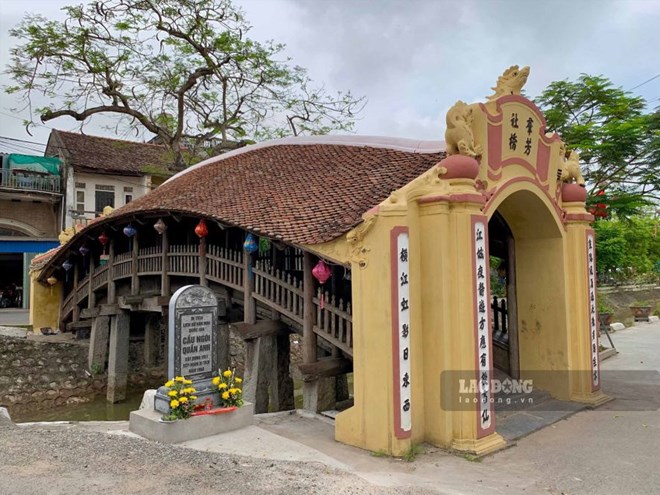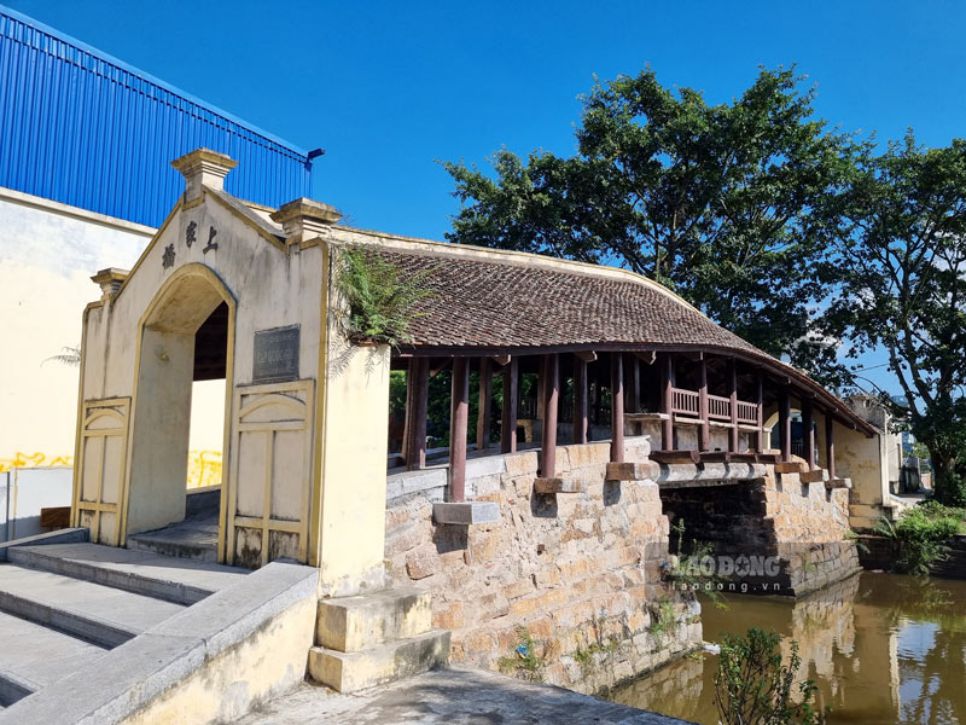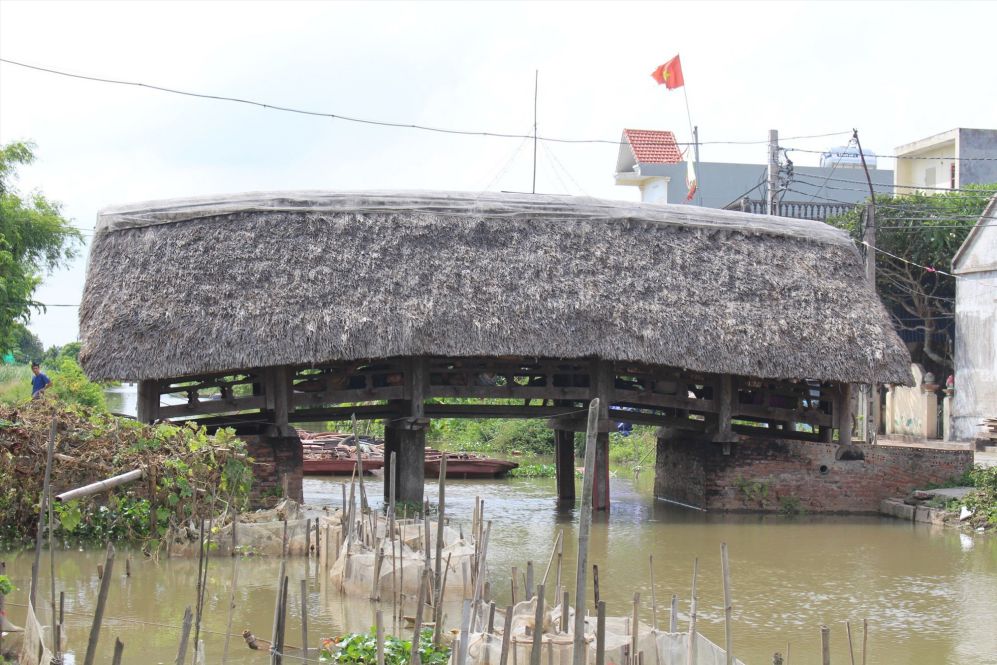
Luong market covered bridge.
Luong market covered bridge
First of all, we must mention the Luong market covered bridge (Hai Anh commune, Hai Hau district, Nam Dinh province), one of the most beautiful ancient bridges in Nam Dinh and famous in Vietnam, becoming an ideal stop for many domestic and international tourists. This bridge dates back to the same period as Luong pagoda (Hong Thuan Tam year, ie 1511) and is one of the 10 oldest bridges in ancient Quan Anh.
Nowadays, the space and appearance of the Luong market covered bridge is as beautiful as a miniature Hoi An in Nam Dinh. Although it has existed for more than 500 years, this covered bridge is still one of the three oldest and most beautiful covered bridges in Vietnam that still retains its original appearance.
Only by admiring the tiled bridge of Luong market with your own eyes can you see the beauty of the architecture of "Thuong gia ha kieu", meaning "above is the house, below is the bridge" and it is built across the Trung Giang river. The bridge is built on 18 square stone pillars, each side is 35cm, arranged in 6 rows to support 6 rafters and support the entire 9 compartments of the bridge. On the stone pillars is a system of large, sturdy ironwood crossbeams and longitudinal beams to support the beams, raise the bridge floor and the bridge.

Thuong Market covered bridge.
Looking closely, visitors can easily see that on both sides of the bridge there are four male chimeras standing in attendance, with a familiar yet majestic appearance but with profound meaning. Like the saying "Four male chimeras attending to their ancestors". The image of a scroll on the pillar, below is a soft-shaped rolling door, inside are the four words "Quan Phuong Xa Kieu", meaning Quan Phuong Commune Bridge (now Hai Anh Commune, Hai Hau District).
"The first time I came to the Luong market covered bridge, I couldn't take my eyes off it and was very impressed with the skillfully laid roof tiles, evenly spaced, without any gaps, like a winding dragon stretching its body to fly up. I stopped in the middle of the bridge, sat on the corridor, my back leaning against the railing, looking at the space inside the bridge. The bridge floor was designed into two distinct parts, while the bridge surface was curved. Sitting to rest, watching the river scenery, I felt the peaceful and gentle countryside" - Ms. Ngo Thi Minh Tam ( Thai Binh ) shared.
The ancient beauty symbolizing the architectural and artistic values imbued with Vietnamese identity of the Luong market covered bridge has become an attractive tourist destination for visitors to Nam Dinh.
Thuong Market covered bridge
Also known for its "Merchant's Bridge" architecture, in Nam Dinh there is also the Thuong Market covered bridge (also known as Thuong Nong covered bridge, Binh Minh commune, Nam Truc district). This is a 17.35m long bridge built during the Later Le Dynasty, with the contribution of Princess Nguyen Thi Ngoc Xuan, concubine of Lord Trinh, who was also a daughter of Thuong Nong village. In 2012, the bridge was ranked as a National Historical and Cultural Relic.
Looking at the overall exterior, it can be seen that the bridge abutment is made very solidly, with monolithic stones built together. The bridge abutment is built in the shape of an isosceles trapezoid. The two abutments are about 5m apart, creating space in the middle for water flow and boats to pass by.
Mr. Nguyen Quang Vinh - an elderly man living near Thuong Nong tile bridge said: "In the past, my whole village had the Thuong market tile bridge, which was the only bridge across the Ngoc River for people to travel. The bridge surface was about 2m wide, paved with alternating green stone blocks; the stone surface was shiny, but not slippery to walk on. The two sides of the bridge corridor were also paved with stone blocks, creating a ledge about 15cm higher than the bridge surface. Every noon, my whole neighborhood would go to the bridge to sit and chat, this is also the place associated with the childhood of our generation".
After more than 300 years, the Thuong market covered bridge still retains the shape of the old bridge, is a stop when exploring Nam Dinh, seeing a beautiful and peaceful ancient bridge in the middle of the countryside, the feeling in the heart is so peaceful and comfortable.
The house is built with ironwood frame, roof covered with tiles, two sides built with walls, rolling door 1.7m wide, 2m high, two sides are two fake doors.
Kenh village bridge
When talking about ancient bridges in Nam Dinh, we cannot help but mention the Kenh village bridge (Co Le town, Truc Ninh district) - the only thatched bridge that still retains the rare historical values of the Vietnamese countryside.
Kenh Village's covered bridge - the "one-of-a-kind" palm-roofed bridge in Vietnam was built during the Ly Dynasty, about 700 years ago, after the royal court ordered the digging of a canal to bring water from the Red River to irrigate an entire area of Son Nam Ha town.

Kenh village bridge.
After 700 years, up to now, the bridge connecting the two banks of Hai Ninh River still retains its ancient and unique architectural structure. According to the elders in the village, the bridge has 5 spans, each span is from 1m45 - 1m65, creating a structure 10m long, 4m wide, 3m high from the floor up. All columns, beams, and bridge floor are made of ironwood, the bridge floor is assembled with thick wooden panels, more than 40cm wide.
The special feature of the Kenh village roofing bridge is that right from the beginning of its construction, the workers did not choose to roof the bridge with tiles but with sedge (sedge), a plant grown in the brackish and salty coastal areas, because sedge is lighter, more porous, and can withstand storms. When the sedge layer rots, people will cover it with a new layer of leaves. Up to now, after many restorations, the bridge roof has been changed to palm leaves instead of sedge leaves. All the palm leaves are tightly attached to the rafters and reinforced with rattan, making the roof of the bridge very sturdy, not afraid of storms damaging it.
With the unique "Merchant's Bridge" architecture, the hundred-year-old bridges in Nam Dinh such as: Luong market tile bridge (Hai Hau district), Kenh village tile bridge (Truc Ninh district), Thuong market tile bridge (Nam Truc district)... all retain their ancient features, lying on the clear blue water, creating a landscape with the charming beauty of Vietnamese countryside.
Source: https://laodong.vn/van-hoa/ve-manh-dat-cua-nhung-cay-cau-co-tram-nam-tuoi-1298566.ldo


![[Photo] General Secretary To Lam chairs the meeting of the Central Steering Committee on preventing and combating corruption, waste and negativity](https://vphoto.vietnam.vn/thumb/1200x675/vietnam/resource/IMAGE/2025/9/29/fb2a8712315d4213a16322588c57b975)
![[Photo] General Secretary To Lam receives US Ambassador to Vietnam Marc Knapper](https://vphoto.vietnam.vn/thumb/1200x675/vietnam/resource/IMAGE/2025/9/29/c8fd0761aa184da7814aee57d87c49b3)
![[Photo] Many streets in Hanoi were flooded due to the effects of storm Bualoi](https://vphoto.vietnam.vn/thumb/1200x675/vietnam/resource/IMAGE/2025/9/29/18b658aa0fa2495c927ade4bbe0096df)
![[Photo] General Secretary To Lam attends the ceremony to celebrate the 80th anniversary of the post and telecommunications sector and the 66th anniversary of the science and technology sector.](https://vphoto.vietnam.vn/thumb/1200x675/vietnam/resource/IMAGE/2025/9/29/8e86b39b8fe44121a2b14a031f4cef46)

![[Photo] National Assembly Chairman Tran Thanh Man chairs the 8th Conference of full-time National Assembly deputies](https://vphoto.vietnam.vn/thumb/1200x675/vietnam/resource/IMAGE/2025/9/29/2c21459bc38d44ffaacd679ab9a0477c)

































































































Comment (0)